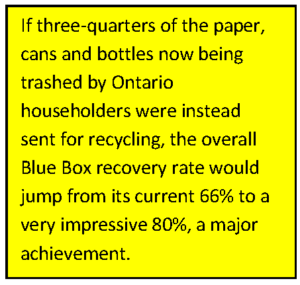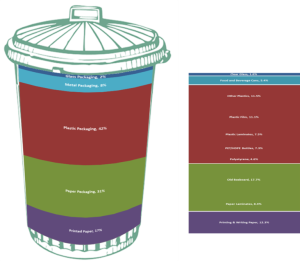Recent studies have highlighted how much food we waste (both in preparation and in the disposal of scraps) but we are also throwing away some perfectly recyclable other stuff, like paper. Why is this, and what can we do about it?
Here’s a look at what Ontario householders put in their trash, somewhat arbitrarily divided into the following three segments: recyclable material that should not be there; problem materials that could be redesigned for recyclability; and material that, at least in the short term, is unlikely to be recycled.
1. Recyclable material that should not be in the garbage
Almost 80% of the paper in Ontario households is recovered by the province’s Blue Box system and sent on for recycling. This is great, but it still means that a lot of paper ends up in landfill: old boxboard cartons, printing and writing paper, even some old newspapers and magazines. You would think that after 30 years of the Blue Box in Ontario that we would be doing much better than this.
Is it lack of education or convenience, or a combination of the two? Millions of dollars have been spent by individual municipalities on Blue Box promotion and education. “We accept this.” “We don’t accept that.” “Throw it all together.” A common province-wide recycling message (“These materials are collected in every single municipality across Ontario”

) would certainly reduce the current confusion and hopefully boost recovery rates.
Many municipalities have tried to encourage better consumer behaviour by limiting the “garbage opportunity”: by making recycling “free” relative to garbage, that is, by charging for garbage bags or bins; by reducing the number of garbage bags allowed at the curb and/or the frequency of garbage pick-up. We recognize that over 50% of Toronto residents now live in apartment buildings, and that this poses a significant recycling challenge. It’s a lot easier to dump something down a garbage chute than to separate the recyclables and carry them in the elevator to a downstairs recycling room.
Another challenge is confidentiality. Householders are reluctant to place their bank/financial statements and bills in the Blue Box. We would suggest buying a good shredder, bagging the shredded paper, and then placing it either in or alongside the Blue Box. And then there’s the human brain. A recent study suggests the human brain is wired to perceive flat paper as recyclable but crumpled up paper as trash. So don’t crumple your paper!
But it’s more than just paper that’s missing from Ontario’s Blue Box. The recovery rates for aluminum and steel beverage cans, and PET and HDPE bottles, are significantly lower than those being achieved in provinces with beverage deposit/refund programs. The missing tonnes are important. If three-quarters of the paper, cans and bottles now being trashed by Ontario householders were instead sent for recycling, the overall Blue Box recovery rate would jump from its current 66% to a very impressive 80%, a major achievement.
2. Problem materials that could be redesigned for better recyclability
These are potentially recyclable items that pose technical challenges to processors because of their material composition. They include multi-layered laminates, compostable plastic containers and trays, black plastic takeout trays and nursery pots, full shrink wrap labels, metallized tubes, single serve hot beverage pods, coloured opaque PET, and non-PET clamshells. For a concise background document on the recycling challenges that these items pose to North American recycling programs, click here.
3. Material that, in the short term at least, is unlikely to be recycled
These are primarily multi-layered paper-based or plastic laminants that serve a packaging function that is not currently technically or economically achievable through the use of a single material type (and therefore likely to be more easily recycled). These and some of the problem materials noted above are often cited as candidates for energy-from-waste treatment rather than recycling.
So that’s what’s in our waste and where we’re falling short. Now we just have to figure out what to do about it.
There’s some good stuff in this trash

Source: PPEC analysis of Stewardship Ontario data for Ontario households (2013).
